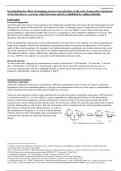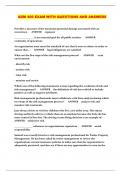Candidate code:
Investigating the effect of changing sucrose concentration on the rate of anaerobic respiration
of Saccharomyces cerevisiae when invertase activity is inhibited by sodium chloride.
Exploration
Personal Engagement
As I bake quite often, I know from experience that adding salt to dough helps slow down the speed the dough rises and
decreases the volume of the bread loaf. I was curious as to why, so through research, I found that salt (NaCl) acted as
an inhibitor for invertase, an enzyme found in Saccharomyces cerevisiae (Baker’s yeast). Since I had learnt about
enzyme inhibition, I questioned whether NaCl acted as a competitive or non-competitive inhibitor for invertase. Thus,
this led me to investigate how invertase activity in S. cerevisiae differed with sucrose concentration, in order to
determine what type of inhibitor NaCl is.
From my preliminary experiments, I discovered that there were many flaws in my method, so I ended up spending far
longer than I thought I would on the preliminary experiments in order to determine the adjustments I would need to
make for the actual experiment. For example, in my initial preliminary experiments, the reaction took too long, so for
the actual experiment, I used a water bath set to a higher temperature and increased the mass of yeast used (more in
‘Deciding the method’ section). Additionally, while processing my data, I learnt how to conduct both one-way and
two-way ANOVA tests and how to extract the useful information from the results.
Research question
To what extent does changing the concentration of sucrose (0.04 mol dm-3, 0.08 mol dm-3, 0.12 mol dm-3, 0.16 mol
dm-3, 0.20 mol dm-3, 0.24 mol dm-3, 0.28 mol dm-3) affect the rate of anaerobic respiration of Saccharomyces
cerevisiae when invertase activity is inhibited by NaCl, as shown by the time taken for 10 cm3 of CO2 gas to be
produced? And therefore, what type of inhibitor is NaCl?
Background information
Anaerobic respiration
Anaerobic respiration is the process of producing ATP from carbohydrates in the absence of oxygen1. Anaerobic
respiration involves two metabolic pathways: glycolysis and fermentation. However, if the sugar is a disaccharide, it
must be hydrolysed into glucose before the two pathways can occur.
Yeasts are microorganisms which respire anaerobically to break down glucose molecules and produce ATP. Invertase
is an enzyme found in S. cerevisiae (Baker’s yeast) responsible for catalysing the hydrolysis of the disaccharide,
sucrose, into the monosaccharides, glucose and fructose2 (as shown in Fig 1). Invertase speeds up the rate of this
reaction as the sucrose substrate binds onto the active site of invertase, which will cause the glycosidic bond in sucrose
to break, forming glucose and fructose. The rate of invertase activity is indicated by the rate of anaerobic respiration.
This enzyme is important in the baking industry, as it aids in
the fermentation of dough by S. cerevisiae in the production
of bread. Yeast converts fermentable sugars into ethanol and
carbon dioxide, the latter of which lifts and aerates the
dough3.
Fig 1: Breakdown of sucrose by invertase4
1 ‘Energy Conversions | BioNinja’, Ib.bioninja.com.au <https://ib.bioninja.com.au/higher-level/topic-8-metabolism-cell/untitled/energy-
conversions.html > [accessed 11 May 2023].
2 M. A. Sainz-Polo and others, ‘Three-Dimensional Structure Of Saccharomyces Invertase’, Journal of Biological Chemistry, 288/14 (2013),
9755-66 <https://www.ncbi.nlm.nih.gov/pmc/articles/PMC3617277/> [accessed 11 May 2023].
3 S. Rodriguez-Velazquez, ‘5.3: The Functions of Yeast’, Chemistry LibreTexts, 2017
<https://chem.libretexts.org/Bookshelves/Biological_Chemistry/Chemistry_of_Cooking_(Rodriguez-
Velazquez)/05%3A_Leavening_Agents/5.03%3A_The_Functions_of_Yeast> [accessed 12 May 2023].
4 S. Kermasha and M. N. A. Eskin, ‘Chapter Nine - Selected Industrial Enzymes’, ed. by S. Kermasha and M. N. A. Eskin, ScienceDirect (San
Diego, 2021), p. 259-305 <https://www.sciencedirect.com/science/article/abs/pii/B9780128002179000095> [accessed 11 May 2023].
, Candidate code:
Step 1: Glycolysis
The first step of anaerobic respiration is glycolysis, which occurs in the cytoplasm of
the cell5. Two phosphate groups attach to glucose, using 2 ATP molecules, to form
fructose biphosphate. This is more unstable, and so splits via lysis into two triose
phosphate molecules. A hydrogen atom is removed from each molecule, oxidising
them. The hydrogen removed reduces NAD+ (electron carrier) to NADH + H+,
resulting in 2 NADH molecules (one from each triose phosphate molecule). The
oxidation of the triose phosphate molecules converts them to 2 pyruvate molecules.
Phosphate groups from the triose phosphate molecules are added to ADP via
substrate-linked phosphorylation to produce a total of 4 ATP molecules6. Thus,
glycolysis, as seen in Fig 2, has a net gain of 2 pyruvate molecules, 2 ATP, and 2
NADH molecules per glucose molecule.
Fig 2: Process of glycolysis7
Step 2: Fermentation
The second step of anaerobic respiration is fermentation8. Pyruvate from glycolysis is decarboxylated by the enzyme
pyruvate decarboxylase to form acetaldehyde and carbon dioxide. Acetaldehyde is then reduced to form ethanol by the
enzyme alcohol dehydrogenase, which transfers hydrogen atoms
from NADH molecules to the acetaldehyde. Therefore,
fermentation results in the production of carbon dioxide and
ethanol, as seen in Fig 3. Thus, in my experiment, the rate of CO2
production is a valid indicator for the rate of anaerobic
respiration, and therefore the rate of invertase activity.
Fig 3: Breakdown of pyruvate in fermentation9
Enzyme inhibition
Enzyme inhibitors are molecules that bind to enzymes to reduce the rate of an enzyme-catalysed reaction10. For
example, NaCl is an inhibitor of the enzyme invertase. Competitive inhibitors are chemically similar to the substrates,
so they directly compete with the substrates to bind to the enzyme’s active site11. Non-competitive inhibitors bind to
another part of the enzyme, the allosteric site, and cause a change to the conformation of the active site12. This
prevents the substrate from binding to the active site, so
prevents the reaction from occurring. The relationship between
substrate concentration and rate of reaction is shown in Fig 4.
In competitive inhibition, the maximum rate of reaction (Vmax)
is unchanged and will eventually be reached at a higher
substrate concentration since the effect of the competitive
inhibitor can be overcome13. However, in non-competitive
inhibition, the Vmax is lowered even if substrate concentration
increases, as the inhibitor reduces the number of functional
enzymes which can catalyse the reaction14.
Fig 4: The effect of sucrose concentration on rate with inhibitors15
5 R. Chaudhry and M. Varacallo, ‘Biochemistry, Glycolysis’, National Library of Medicine (2019)
<https://www.ncbi.nlm.nih.gov/books/NBK482303/> [accessed 12 May 2023].
6 ‘Glycolysis (5.7.4) | OCR a Level Biology Revision Notes 2017’, Save My Exams <https://www.savemyexams.co.uk/a-
level/biology/ocr/17/revision-notes/5-communication-homeostasis--energy/5-7-respiration/5-7-4-glycolysis/> [accessed 13 May 2023].
7 ‘#87 Respiration, Glycolysis’, Blogspot.com, 2020 <http://biology4alevel.blogspot.com/2015/08/87-respiration-glycolysis.html> [accessed 14
May 2023].
8 ‘13.2: Fates of Pyruvate under Anaerobic Conditions- Fermentation’, Biology LibreTexts, 2018
<https://bio.libretexts.org/Bookshelves/Biochemistry/Fundamentals_of_Biochemistry_(Jakubowski_and_Flatt)/02%3A_Unit_II-
_Bioenergetics_and_Metabolism/13%3A_Glycolysis_Gluconeogenesis_and_the_Pentose_Phosphate_Pathway/13.02%3A_Fates_of_Pyruvate_u
nder_Anaerobic_Conditions-_Fermentation> [accessed 12 May 2023].
9 ‘13.2 Fates of Pyruvate under Anaerobic Conditions- Fermentation’. [accessed 12 May 2023].
10 BioNinja, ‘Enzyme Inhibition | BioNinja’, Bioninja.com.au, 2019 <https://ib.bioninja.com.au/higher-level/topic-8-metabolism-cell/untitled-
6/enzyme-inhibition.html> [accessed 11 May 2023].
11
L. R. Engelking, ‘Chapter 6 - Enzyme Kinetics’, ed. By Larry R Engelking, ScienceDirect, (Boston, 2015), p. 32-38
<https://www.sciencedirect.com/science/article/abs/pii/B9780123919090500062> [accessed 13 May 2023].
12 A. S. Cole and J. E. Eastoe, ‘Chapter 6 - Enzymes’, ed. by A. S. Cole and J. E. Eastoe, ScienceDirect (1988), p. 71-89
<https://www.sciencedirect.com/science/article/abs/pii/B9780723617518500132> [accessed 13 May 2023].
13 Engelking, ‘Chapter 6 - Enzyme Kinetics’, p. 32-38.
14 Cole and Eastoe, ‘Chapter 6 - Enzymes’, p. 71-89.
15 ‘Effect of Enzyme Inhibition on Enzymatic Reaction - Creative Enzymes’, www.creative-enzymes.com, <https://www.creative-
enzymes.com/resource/effect-of-enzyme-inhibition-on-enzymatic-reaction_49.html> [accessed 14 May 2023].





